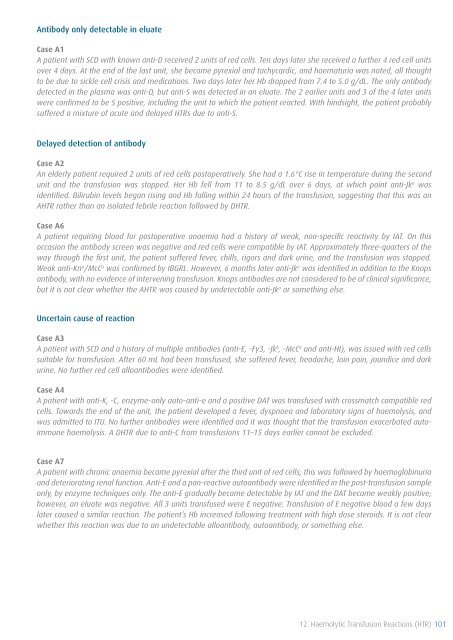SHOT Annual Report 2009 - Serious Hazards of Transfusion
SHOT Annual Report 2009 - Serious Hazards of Transfusion
SHOT Annual Report 2009 - Serious Hazards of Transfusion
Create successful ePaper yourself
Turn your PDF publications into a flip-book with our unique Google optimized e-Paper software.
Antibody only detectable in eluate<br />
Case A1<br />
A patient with SCD with known anti-D received 2 units <strong>of</strong> red cells. Ten days later she received a further 4 red cell units<br />
over 4 days. At the end <strong>of</strong> the last unit, she became pyrexial and tachycardic, and haematuria was noted, all thought<br />
to be due to sickle cell crisis and medications. Two days later her Hb dropped from 7.4 to 5.0 g/dL. The only antibody<br />
detected in the plasma was anti-D, but anti-S was detected in an eluate. The 2 earlier units and 3 <strong>of</strong> the 4 later units<br />
were confirmed to be S positive, including the unit to which the patient reacted. With hindsight, the patient probably<br />
suffered a mixture <strong>of</strong> acute and delayed HTRs due to anti-S.<br />
Delayed detection <strong>of</strong> antibody<br />
Case A2<br />
An elderly patient required 2 units <strong>of</strong> red cells postoperatively. She had a 1.6°C rise in temperature during the second<br />
unit and the transfusion was stopped. Her Hb fell from 11 to 8.5 g/dL over 6 days, at which point anti-Jk a was<br />
identified. Bilirubin levels began rising and Hb falling within 24 hours <strong>of</strong> the transfusion, suggesting that this was an<br />
AHTR rather than an isolated febrile reaction followed by DHTR.<br />
Case A6<br />
A patient requiring blood for postoperative anaemia had a history <strong>of</strong> weak, non-specific reactivity by IAT. On this<br />
occasion the antibody screen was negative and red cells were compatible by IAT. Approximately three-quarters <strong>of</strong> the<br />
way through the first unit, the patient suffered fever, chills, rigors and dark urine, and the transfusion was stopped.<br />
Weak anti-Kn a /McC a was confirmed by IBGRL. However, 6 months later anti-Jk a was identified in addition to the Knops<br />
antibody, with no evidence <strong>of</strong> intervening transfusion. Knops antibodies are not considered to be <strong>of</strong> clinical significance,<br />
but it is not clear whether the AHTR was caused by undetectable anti-Jk a or something else.<br />
Uncertain cause <strong>of</strong> reaction<br />
Case A3<br />
A patient with SCD and a history <strong>of</strong> multiple antibodies (anti-E, -Fy3, -Jk b , -McC a and anti-HI), was issued with red cells<br />
suitable for transfusion. After 60 mL had been transfused, she suffered fever, headache, loin pain, jaundice and dark<br />
urine. No further red cell alloantibodies were identified.<br />
Case A4<br />
A patient with anti-K, -C, enzyme-only auto-anti-e and a positive DAT was transfused with crossmatch compatible red<br />
cells. Towards the end <strong>of</strong> the unit, the patient developed a fever, dyspnoea and laboratory signs <strong>of</strong> haemolysis, and<br />
was admitted to ITU. No further antibodies were identified and it was thought that the transfusion exacerbated autoimmune<br />
haemolysis. A DHTR due to anti-C from transfusions 11–15 days earlier cannot be excluded.<br />
Case A7<br />
A patient with chronic anaemia became pyrexial after the third unit <strong>of</strong> red cells; this was followed by haemoglobinuria<br />
and deteriorating renal function. Anti-E and a pan-reactive autoantibody were identified in the post-transfusion sample<br />
only, by enzyme techniques only. The anti-E gradually became detectable by IAT and the DAT became weakly positive;<br />
however, an eluate was negative. All 3 units transfused were E negative. <strong>Transfusion</strong> <strong>of</strong> E negative blood a few days<br />
later caused a similar reaction. The patient’s Hb increased following treatment with high dose steroids. It is not clear<br />
whether this reaction was due to an undetectable alloantibody, autoantibody, or something else.<br />
12. Haemolytic <strong>Transfusion</strong> Reactions (HTR) 101












